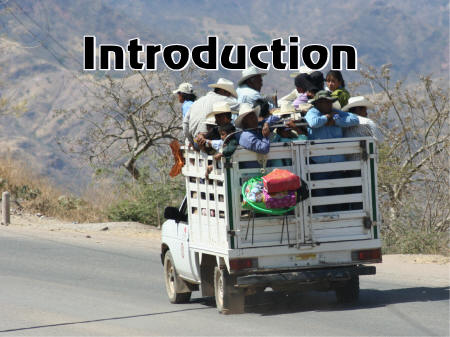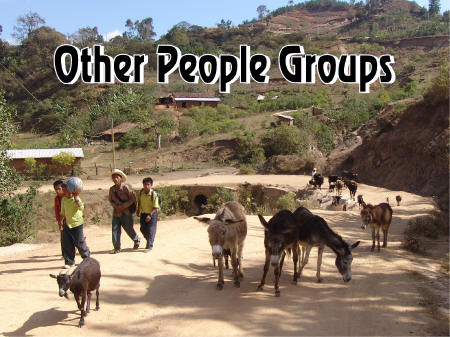|
 Indigenous People Mexico
Indigenous People Mexico
HOME
Video Resource Material
from CRF Media
DOWNLOAD
04 Aug 2011
The videos provide a variety of information concerning the people, their
environment, and their culture as well as how you can become involved in
reaching the peoples Indigenous Peoples of Mexico for Christ. A brief summary
of each of the chapters is provided below.
|
 The
Indigenous People of Mexico: One Story for All
The
Indigenous People of Mexico: One Story for All
Filmed 2004-2006
The indigenous people …
those who lived in Mexico before the arrival of the Spanish
colonists … make up about 10% of the country’s population. There
are 62 officially recognized indigenous tribal groups. Among
these people, over 300 dialects and languages are spoken. The
clothes they wear, the language they speak, the place they live
and their traditional worship practices distinguish one group from
another. Histoira Unica, … the one story concept, …
makes use of the story-telling skills of the various indigenous
people groups. The stories are taught in a manner that even those
who are unable to read can repeat them to their family, their
friends and others who share a common language and cultural bond.
These stories explain who Jesus Christ is but, … still, ... it is
difficult to commit their lives to Jesus Christ because of their
traditional beliefs.
Note:
Chapters marked HD are available
as High definition video. Find
out more.
DVD case
cover pdf file
Flyer insert pdf file
|
|
 Histoira Unica:
One Story for All
HD
7:47 The indigenous people, those who lived in Mexico
before the arrival of the Spanish colonists, make up about 10% of
Mexico's population. There are 62 officially recognized
indigenous tribal groups. Among these people, over 300 dialects
and languages are spoken. The clothes they wear, the language
they speak, the place they live and their traditional worship
practices distinguish one group from another. Histoira Unica:
One Story for All
HD
7:47 The indigenous people, those who lived in Mexico
before the arrival of the Spanish colonists, make up about 10% of
Mexico's population. There are 62 officially recognized
indigenous tribal groups. Among these people, over 300 dialects
and languages are spoken. The clothes they wear, the language
they speak, the place they live and their traditional worship
practices distinguish one group from another.
Santo Niño
HD
4:00
Each year on February the second,
people from all over the country dress up their special dolls and
bring them to the priest. To an outsider, it appears that those
entering the church are simply carrying a large well-dressed doll,
but … to the participants … it is Santo Niño,
the Holy Child. As representations of the Baby Jesus, the
dolls are brought up to the front of the church and placed on the
altar where the priest bestows a special blessing on each. They
are thought to impart protection, health and good fortune to the
owner and to the household. Friends and family come to pray to a
sanctified doll and the owner is paid for the privilege.
The
Queen of Mexico 5:05
The Virgin of Guadalupe is the
object of the faith and adoration of most of the people of Mexico
as well as other Latin American countries.
Her image is everywhere; … in roadside
shrines, … small and large statues along the road, … an emblem on
a truck, … proudly displayed on a t-shirt, and … as the central
monument in many Catholic churches.
|
|
 Workers
from the Hills
12:02
The Mazateco People,
about 350,000 in all, call themselves “workers from the hills,
humble, people of custom". The homeland of the Mazateco
People is a beautiful but a difficult place to live and difficult
to visit. Yet, it is a place that you will enjoy while walking
among these people that know little of the outside world. Workers
from the Hills
12:02
The Mazateco People,
about 350,000 in all, call themselves “workers from the hills,
humble, people of custom". The homeland of the Mazateco
People is a beautiful but a difficult place to live and difficult
to visit. Yet, it is a place that you will enjoy while walking
among these people that know little of the outside world.
LORD, Give Us These
Mountains
8:27 The homeland of the Mazateco People
is in the rugged Sierra Madres of southern Mexico. Catholic
churches abound in this area. Some of these churches are
centuries old but all are the town’s central focus. Inside homes,
as well as in the churches, religious symbolism is pervasive.
Small churches are reaching out into the homes and communities of
these mountains with the Good News of Jesus. The hope for the
future of the Mazatecos of today lies with the few dedicated
people who have set a goal of having a church with trained leaders
in every village by the year 2010. |
|
 The Mixteco People
8:36 The rugged Mixteca Mountains of southern Mexico is the birthplace
of a great and noble people. Even before the Mayans … before the
Aztecs, there were the Mixteco People. The Mixteco People
migrated throughout the Americas but most live in southern Mexico
mainly in the State of Oaxaca. Today, the Mixteco population
totals about 400,000. The Mixteco People
8:36 The rugged Mixteca Mountains of southern Mexico is the birthplace
of a great and noble people. Even before the Mayans … before the
Aztecs, there were the Mixteco People. The Mixteco People
migrated throughout the Americas but most live in southern Mexico
mainly in the State of Oaxaca. Today, the Mixteco population
totals about 400,000.
Mixteca Baja
5:25 The Mixteca Baja People are located in
the lowlands and foothills of the Sierra Madre about 150 miles
southwest of Mexico City in the State of Oaxaca. There are
many small towns and cities scattered throughout these hills,
valleys, and plains. Generations have come and gone but little
has changed in the lives of the Mixteca Baja.
Esquela de Misiones
3:15
Established in 2001, the school of missions is held
quarterly in different parts of the country. Today classes are
being held in the town of Tehuacan. This is one of four
theological training schools located among the indigenous people
of Mexico in Chiapas, Nayarit and the Sierra Mazateco.
The Mixteco Way
- Corn: A Gift From The Gods
HD
5:47 The Mixteco
People believe that corn is the basis of all
physical life. The divine relationship between the original people of Mexico and
that of corn is nowhere more evident than among the Mixtecos who
inhabit the mountains and valleys of southwest Mexico in the State
of Guerrero.
|
|
 The Nahuatl People 7:38 Fifty years before
Columbus discovered America, the Aztec Empire had become the new
Mexican nation. In the 1500’s, the Spanish destroyed the Aztec
Empire. Today, there is a remnant of about 2-1/2 million
descendents of the Aztec scattered throughout central and southern
Mexico but they are no longer called Aztec. Instead, they are
called “speakers of Nahuatl” or simply “the Nahuatl”.
There are over
25 dialects of Nahuatl spoken. Some
live in the lowlands tending large irrigated farms while others
work the soil along the steep mountain slopes. The Nahuatl People 7:38 Fifty years before
Columbus discovered America, the Aztec Empire had become the new
Mexican nation. In the 1500’s, the Spanish destroyed the Aztec
Empire. Today, there is a remnant of about 2-1/2 million
descendents of the Aztec scattered throughout central and southern
Mexico but they are no longer called Aztec. Instead, they are
called “speakers of Nahuatl” or simply “the Nahuatl”.
There are over
25 dialects of Nahuatl spoken. Some
live in the lowlands tending large irrigated farms while others
work the soil along the steep mountain slopes.
The Burro
HD 4:48 The
people now known as the Nahuatl Guerrero and the burro depend upon each other for their survival. The
burro is an essential part of life in the southwestern Mexican
State of Guerrero. This is a place where the roads are few, the
mountains slopes are steep, and the green valleys are often only
in the distance.
|
|
 We Are Me’phaa – NOT Tlapaneco
HD
9:10
The city of Tlapa is in the state of
Guerreo. A’phaa, the place we once called home, was located
here. The Aztecs destroyed our life and our people were nearly
all killed. The Aztecs, called us “Tlapaneco” which means,
“dirty faced ones” in the Aztec language. Today few of the 60,000
residents are Me’phaa. We Are Me’phaa – NOT Tlapaneco
HD
9:10
The city of Tlapa is in the state of
Guerreo. A’phaa, the place we once called home, was located
here. The Aztecs destroyed our life and our people were nearly
all killed. The Aztecs, called us “Tlapaneco” which means,
“dirty faced ones” in the Aztec language. Today few of the 60,000
residents are Me’phaa.
Be’ena’a ..."The
People"
9:20 “The
People”, now known as Zapotecs, have lived in these
mountains for more than three thousand years. In the city of
Oaxaca, with a population of four million people, over 60%
are Zapotecs.
For the most part, the Zapotecs living
in and around Oaxaca have become a part of the Mexican culture but
there are many who never venture far from their homes in the
mountains. This is where the Be’ena’a still live. Their life
style has changed little over the centuries. Many speak only
Zapotec. In the State of Oaxaca, there are approximately 150,000
cultural Zapotecos speaking many different Zapotec dialects.
Remaking Chiapas 10:05 This area has been remade many times over
the centuries. It was here in southern Mexico and Central
America that the Mayan culture once flourished. Today, in
the southern State of Chiapas, there are about 750,000 indigenous
people. For them … as it was for their ancestors, … the
change from power and prestige to poverty is painful
|
|
Statement
About Video Availability
The videos and other media material produced by CRF
Media are to be used as a resource material for increasing the
awareness of and involvement with the specific
people groups featured in the material. The information is made available to evangelical
Christian organizations and individuals who commit to sharing the
information with others.
The videos produced by CRF Media are not for
sale. They are free to qualified organizations and
individuals with no postage or handling charges. We mail the material only to churches or other
qualified organizations. We do not mail to individuals without
independent qualifying verification.
U.S.
copyright laws protect all media material produced by CRF Media.
The material is not to be copied for distribution without the
written consent of CRF Media.
Contact us for more information.
|
|




 The Mixteco People
The Mixteco People
